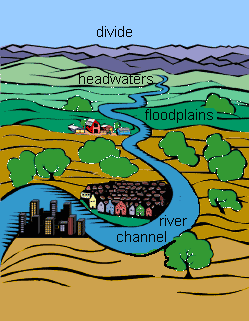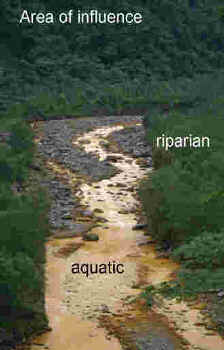 |
| Diagram of a watershed |
WATERSHEDS
A watershed or drainage basin refers to a system controlled by topography which defines how water will flow. You refer to a watershed by the largest body of water that the creeks, rivers or streams feed into. For example, all creeks that flow in the San Francisco Bay are part of the San Francisco Watershed. However, there are many smaller watersheds within this area depending on flow patterns. Alameda Creek Watershed would be an area that drains into Alameda Creek.
 |
| Diagram of a watershed |
When it rains, water will flow into its appropriate watershed. A ridge or topographical higher areas that connects two waters are called a divide. In the United States there is an area in the Rocky Mountain called the "continental divide." This refers to water on the east of the divide flows into the Atlantic. The water on the west side flows into the Pacific
A watershed has an orderly flow pattern. The pattern is dendritic or branching, as it flows from the headwaters to a larger body of water. When one stream flows into a larger stream or river they are called tributaries. The smallest channels in a watershed with no tributaries are called first order streams. A second order stream is when two first order streams join. If you look at the stream order diagram, you can see the creation of a fifth order stream channel. Fifth to sixth order streams are usually larger rivers, while first and second order are often small, steep, or intermittent.
Watersheds are affected by different physical and climatic differences. Climates refer to the weather in a region over a long period of time. Your location will determine the type of the seasonal input of water. Temperature of the atmosphere caused by solar radiation will also control the rate and nature of the precipitation.
Physical make-up of the area where water flows will also make a difference. If the rocks and soil are "soft," water can erode it easily. The steeper the topography the greater the runoff and erosion. An earthquake can cause an uplift in an area that can change the shape and extend of how the water flows. Humans can create a dam or build a large structure which change the course of a river, which effect an entire area.
The vegetation in watersheds effects the quality of the water. Grasses, shrubs, and trees make up the majority of plant cover. As they fall and decompose, they add the organic components to the soil. Trees are the protectors of the watershed. The tree litter protects the soil
’s surface as the roots of the tree protect the soil from erosion. Trees also provide a canopy that keeps the water cool so organisms don’t die of thermal pollution. The canopy can also reduce the force of the rain and the velocity of wind in a watershed.Plant cover is important to a watershed to prevent the erosion of valuable soil as water rushes downstream. Plant cover also provides food and protection for many small organisms.
 |
| Stream ecosystem |
The green zone along a stream ecosystem is called a riparian area and has several unique properties. Riparian zones have the capacity to buffer rivers and other waters from runoff from agricultural, urban, or other areas. Healthy riparian zones can absorb sediments, chemical nutrients, and other substances contained in runoff.
Riparian areas provide all the components needed for a wildlife habitat including food, water, and cover. Diversity of organisms living in these wetland areas is very high. A riparian habitat includes three areas depending on the influence of water. The aquatic area refers to the area that is the stream channel or pond. The organisms that live in this area must be adapted to a wet lifestyle. Not far from the banks of the water is an area referred to as the riparian area which are organisms that require a moist habitat. Many plants require their roots to be moist. A transition area between a riparian area and upland cover is called an area of influence. Moisture decreases as you move away from the water.
Riparian vegetation adds to the shade of an area which helps to control temperature and photosynthesis of plants living in the stream. It also is a source of larger and fine plant detritus which is used by many insects and invertebrates for their food source. If you have a vigorous riparian zone, you will have a diverse flora and fauna living in this area.
Watersheds naturally clean themselves as water can be filtered as it flows in the system. However, we sometimes pollute these watersheds through industrial or municipal waste discharging into the watershed (point source pollution). This overloads the systems and pollution increases. Even non point source pollution (many contributors to pollution) can accumulate and cause as much damage. Our watersheds reflect the health of our environment. Water that migrates through the different levels of the watershed nourishes biological life.